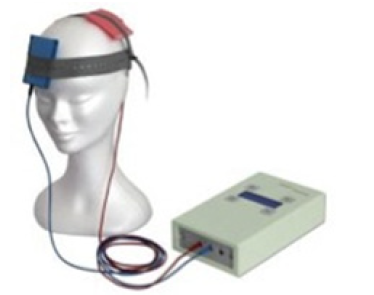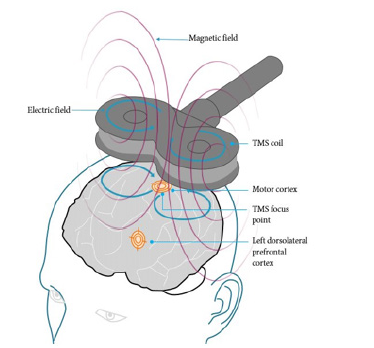Review Article 
 Creative Commons, CC-BY
Creative Commons, CC-BY
Innovations in Neuromodulation The Role of Biomedical Science in Transcranial Magnetic and Electrical Stimulation for Neurological Disorder Treatment
*Corresponding author: Bahman Zohuri, Adjunct Professor, Golden Gate University, Ageno School of Business, San Francisco, California, USA 94105.
Received: October 25, 2024; Published: October 28, 2024
DOI: 10.34297/AJBSR.2024.24.003217
Abstract
Neurological disorders, affecting approximately one billion people globally, present significant challenges in treatment and management. Traditional pharmacological approaches often fall short, leading to the exploration of alternative therapies. Recent advancements in biomedical science have highlighted the potential of non-invasive neuromodulation techniques, specifically Transcranial Magnetic Stimulation (TMS) and Transcranial Electrical Stimulation (TES), as effective treatments for a range of neurological and psychiatric conditions. These methods leverage the brain’s neuroplasticity to promote recovery and improve functioning, offering hope to patients who have not responded to conventional therapies. TMS employs magnetic fields to stimulate nerve cells, while TES uses electrical currents to modulate neuronal activity, both targeting specific brain regions with minimal risk. As research into their mechanisms and applications expands, TMS and TES are gaining recognition for their role in managing conditions such as depression, anxiety, chronic pain, and stroke rehabilitation. This article examines the principles, clinical applications, current research, and challenges of TMS and TES, emphasizing the transformative impact of biomedical science on neurological disorder treatment and the potential for personalized, effective interventions that enhance patient outcomes.
Keywords: Neurological Disorders, Transcranial Magnetic Stimulation (Tms), Transcranial Electrical Stimulation (Tes), Neuromodulation, Neuroplasticity, Depression, Chronic Pain, Personalized Therapy, Biomedical Science, Non-Invasive Treatment
Introduction
Neurological disorders, encompassing a wide range of conditions affecting the brain and nervous system, have long posed significant challenges to healthcare. Conditions such as depression, epilepsy, and chronic pain impact millions worldwide, necessitating the development of innovative treatment modalities. In recent years, biomedical science has emerged as a pivotal player in the advancement of neuromodulation techniques, particularly through Transcranial Magnetic Stimulation (TMS) and Transcranial Electrical Stimulation (TES) [1,2]. These non-invasive brain stimulation methods offer promising avenues for therapeutic intervention, enhancing the lives of patients suffering from various neurological disorders.
Moreover, Neurological disorders encompass a broad spectrum of conditions that affect the brain and nervous system, leading to a variety of physical, cognitive, and emotional impairments. These disorders, including epilepsy, Alzheimer's disease, multiple sclerosis, and depression, present significant challenges not only for patients but also for healthcare systems worldwide. According to the World Health Organization, approximately one billion people are affected by neurological disorders, underscoring the urgent need for effective treatments.
Traditionally, management strategies for these conditions have relied heavily on pharmacological interventions, which often come with limitations such as delayed onset of action, side effects, and variability in patient response. As a result, many patients experience inadequate relief, prompting the exploration of alternative therapies that can complement or enhance existing treatment options.
In recent years, advancements in biomedical science have led to the emergence of non-invasive neuromodulation techniques, specifically Transcranial Magnetic Stimulation (TMS) and Transcranial Electrical Stimulation (TES). These innovative methods harness the brain's neuroplasticity-the ability to reorganize and adapt-to promote recovery and improve overall functioning in individuals with neurological disorders.

Figure 2: TES Treatment Concept.
Note*: (Source: https://bodywinning.com/ab-stimulator/best-reviews).
The potential of TMS (Figure 1, TMS concept) and TES (Figure 2, TES concept) is particularly noteworthy, as these techniques target specific brain regions without the need for surgical intervention or systemic medication. This not only minimizes risks associated with traditional treatments but also opens new avenues for personalized therapy tailored to individual patient needs. Moreover, the non-invasive nature of these techniques makes them more accessible, expanding treatment options for patients who may be hesitant to pursue invasive procedures or those who have not responded to conventional therapies.
As the field of biomedical science continues to evolve, research into the mechanisms, applications, and efficacy of TMS and TES is rapidly expanding. Clinical trials are underway to explore their impact on a variety of neurological and psychiatric conditions, while ongoing studies aim to refine treatment protocols and understand the underlying biological processes at play. This surge in interest highlights the growing recognition of the importance of neuromodulation in the therapeutic landscape of neurological disorders. [3-12].
In this article, we will delve deeper into the principles of TMS and TES, explore their clinical applications, examine current research trends, and address the challenges that lie ahead in their implementation. By understanding the potential of these innovative approaches, we can appreciate the transformative role biomedical science plays in the treatment of neurological disorders and the hope it offers to millions of individuals seeking effective solutions for their conditions.
Understanding Transcranial Magnetic and Electrical Stimulation
Transcranial Magnetic Stimulation (TMS) involves the use of magnetic fields to stimulate nerve cells in the brain. A coil placed on the scalp generates magnetic pulses, which induce electrical currents in specific brain regions. TMS has gained recognition for its efficacy in treating major depressive disorder, with studies indicating its potential to alleviate symptoms in patients unresponsive to conventional treatments.
Transcranial Electrical Stimulation (TES), on the other hand, utilizes small electrical currents delivered through electrodes placed on the scalp. This technique modulates neuronal activity, influencing brain function. Variants of TES, such as transcranial Direct Current Stimulation (tDCS), have shown promise in treating conditions like anxiety, stroke rehabilitation, and chronic pain.
Mechanisms of Action
The mechanisms underlying TMS and TES are complex and still under investigation. (i.e., Figure-3).

Figure 3: Schematic-Diagram-of-the-Mechanisms-Underlying-TRAIL-and-TMS-Mediated-Apoptosis in Osteosarcoma.
Note*: (Source: Oxidative Medicine and Cellular Longevity).
However, several theories have emerged:
1. Neuroplasticity: Both TMS and TES are believed to promote neuroplasticity, the brain's ability to reorganize and form new neural connections. This is crucial in recovery from neurological disorders, as it may help restore lost functions or compensate for damaged areas.
2. Modulation of Neurotransmitters: These techniques can influence the release of neurotransmitters such as serotonin, dopamine, and glutamate, which play vital roles in mood regulation and cognitive function.
3. Restoration of Brain Connectivity: TMS and TES can enhance connectivity between different brain regions, improving overall cognitive and emotional functioning.
TMS and TES operate by promoting neuroplasticity, modulating neurotransmitter release, and enhancing brain connectivity, which collectively contribute to their therapeutic effects in treating neurological disorders.
Clinical Applications
The applications of TMS and TES extend across a spectrum of neurological and psychiatric disorders:
1. Major Depressive Disorder: TMS has been FDA-approved for treating depression, offering a viable alternative for patients who do not respond to medications.
2. Anxiety Disorders: TES, particularly tDCS, is being investigated for its efficacy in treating anxiety disorders, with preliminary studies showing positive results.
3. Chronic Pain Management: Both TMS and TES have demonstrated potential in alleviating chronic pain conditions, such as fibromyalgia and neuropathic pain.
4. Stroke Rehabilitation: These techniques are being explored to enhance recovery post-stroke by promoting motor function and cognitive recovery.
In summary, Transcranial magnetic stimulation (TMS) and transcranial electrical stimulation (TES) are being effectively utilized in clinical settings to treat a variety of neurological and psychiatric disorders, including major depressive disorder, anxiety, chronic pain, and stroke rehabilitation, offering hope for improved patient outcomes.
Current Research and Future Directions
Biomedical science continues to push the boundaries of knowledge regarding TMS and TES. Ongoing clinical trials are investigating their long-term effects, optimal stimulation parameters, and combinations with other therapeutic modalities, such as pharmacotherapy and cognitive-behavioral therapy.
Furthermore, advancements in brain imaging techniques, such as functional MRI and EEG, are enabling researchers to better understand the effects of neuromodulation on brain activity and connectivity. This knowledge may pave the way for personalized treatment approaches tailored to individual patient profiles.
Challenges and Considerations
Despite the promising results, several challenges remain in the implementation of TMS and TES:
1. Accessibility: The availability of these treatments is often limited by cost and the need for specialized equipment and trained personnel.
2. Standardization: There is a need for standardized protocols regarding stimulation parameters, treatment duration, and session frequency to ensure consistent and effective outcomes.
3. Regulatory Hurdles: As the field evolves, navigating the regulatory landscape for new devices and techniques poses challenges for researchers and clinicians alike.
In summary, Despite the promising potential of Transcranial Magnetic Stimulation (TMS) and transcranial electrical stimulation (TES) in treating neurological disorders, several challenges remain. Accessibility is a significant issue, as these treatments often require specialized equipment and trained personnel, which can limit their availability in certain healthcare settings. Additionally, the lack of standardized protocols regarding stimulation parameters and treatment duration can lead to variability in patient outcomes. Regulatory hurdles also pose challenges as the field evolves, necessitating careful navigation to ensure the safety and efficacy of new devices and techniques. Addressing these challenges is crucial for maximizing the impact of TMS and TES in clinical practice.
Conclusion
Biomedical science is at the forefront of revolutionizing the treatment of neurological disorders through innovative techniques like transcranial magnetic and electrical stimulation. These non-invasive approaches offer hope for patients seeking relief from debilitating conditions, demonstrating the potential for neuromodulation to change lives. As research progresses and technologies advance, the future of neurological disorder treatment looks promising, with the potential for tailored, effective interventions that harness the brain's remarkable capacity for change.
In conclusion, this article highlights the significant contributions of biomedical science to the field of neuromodulation, emphasizing the impact of TMS and TES in treating neurological disorders.
References
- Bahman Zohuri and Patrick J McDaniel (2022) Transcranial Magnetic and Electrical Brain Stimulation for Neurological Disorders, Academic Press.
- Bahman Zohuri and David R. Modisette (2019) Electrical Brain Stimulation to Treat Neurological Disorder. Journal of Health Science 123-128.
- George, MS, Post RM (2011) Transcranial magnetic stimulation: applications in neuropsychiatry. Neuropsychiatric Disease and Treatment 7: 577-585.
- Baker KB, McNair K (2018) Transcranial magnetic stimulation for the treatment of depression: A review of the evidence. Psychiatric Clinics of North America 41(3): 493-507.
- Nitsche MA, Paulus W (2000) Excitability changes induced in the human motor cortex by weak transcranial direct current stimulation. Journal of Physiology 527(3): 633-639.
- Fregni F, Pascual Leone A (2007) Handbook of Transcranial Magnetic Stimulation. Nature Publishing Group.
- Kuo MF, Nitsche MA (2012) Assessment of the efficacy and safety of transcranial direct current stimulation in neuropsychiatric disorders. Brain Stimulation 5(3): 245-252.
- Holtmann M, Dorr R (2020) Transcranial Magnetic Stimulation in Children and Adolescents: A Review of Clinical Applications. Clinical Neurophysiology Practice 5: 101-110.
- Reardon JP, et al., (2007) Efficacy of Transcranial Magnetic Stimulation in the Treatment of Major Depressive Disorder: A Meta-Analysis. Psychiatric Services 58(5): 727-734.
- Fitzgerald PB, et al., (2006) A randomized, controlled trial of the efficacy of repetitive transcranial magnetic stimulation in the treatment of major depression. Psychological Medicine 36(10): 1399-1408.
- Lefaucheur JP, et al., (2014) Evidence-based guidelines on the use of transcranial magnetic stimulation (TMS) in the treatment of depression. Clinical Neurophysiology 125(11): 2149-2161.
- Ruffini G, et al., (2014) Electroencephalography and transcranial electrical stimulation. Nature Reviews Neuroscience, 15(3): 163-176.




 We use cookies to ensure you get the best experience on our website.
We use cookies to ensure you get the best experience on our website.